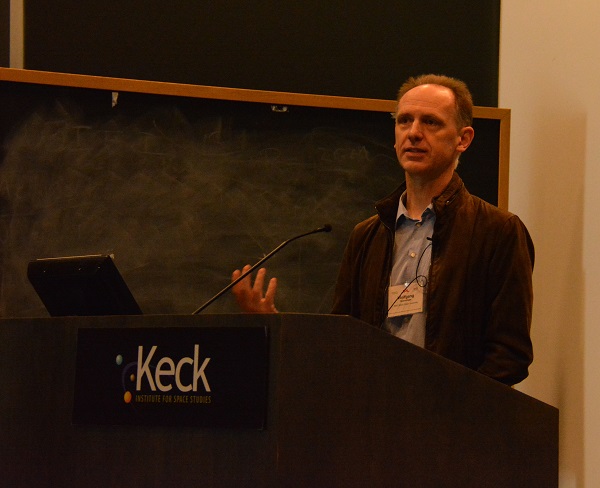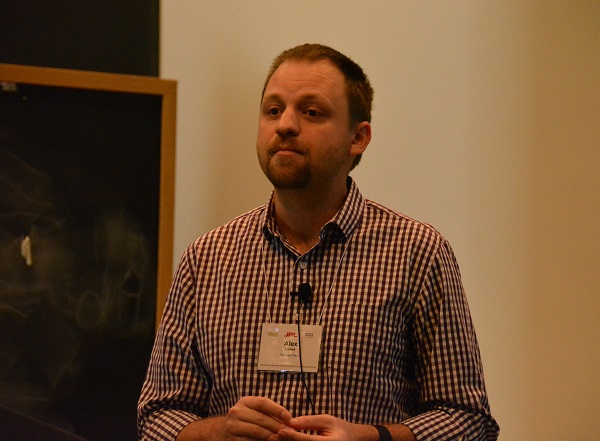by Dot Cannon
How might we use VR and AR in the future?
That was the focus of Caltech’s “Virtual and Augmented Reality for Space Science and Exploration” symposium, in Pasadena on Tuesday.

“There’s something that comes after the Web and the Internet,” said symposium co-organizer Dr. S. George Djorgovski, during the first session at the Keck Institute for Space Studies.
“The interesting question is, what?”
Throughout the day, a series of speakers and panels would look at ways to answer that question, while exploring the roles of cutting-edge VR and AR technology in future scientific advances.
As the opening speaker, Dr. Djorgovski started with some historical background.
“Ten years ago, a group of friends experimented with the uses of VR,” he explained. “We found out, even back then, that this technology was already a killer app for human interaction.”
Djorgovski, who is both Caltech’s Department Chair for Astronomy and the Director of the Center for Data Driven Discovery, said VR’s immersion factor was key.
“Somehow, being inside the data, looking out, was way more intuitive (than looking at it two-dimensionally),” he commented.
But, he continued, acceptance of VR was slow in coming, in the academic community. Ten years ago, virtual reality was considered a gaming technology–period.

“People just did not like it,” Djorgovski said. “But that’s changed now.”
The change, he explained, was due to the additional capabilities available with VR.
“Traditional data visualization doesn’t reveal hidden complex patterns,” Djorgovski said. “With virtual reality, humans could possibly see up to twelve dimensions. (We could) make data points spin or glow (or sing).”
VR’s pros and cons
Making sense of visual analytics is one of VR’s strengths, said speaker Dr. Wolfgang Stuerzlinger.
“(That’s) where large displays for VR can shine. It makes it easy to access a lot of information…one area where VR can really shine is presentation.”
But Dr. Stuerzlinger, who is both a Professor of Interactive Arts and Technology and the director of the VVISE lab at British Columbia’s Simon Fraser University, also referenced some of the obstacles to VR becoming mainstream.
One of them, he said, was finding a viable means of navigation.

“Interacting like this is great for five minutes,” he said, raising his arms. “(But) how long can you keep your hands up? It’s tiring…At the moment, the 3D devices we have cannot compete with the mouse.”
In addition, he said, legibility was an issue.
“If you put a piece of paper (here or there), you can read it,” he explained, moving a paper up and down.
“If you put the same piece of paper in a VR display, (you can’t). There’s a limiting factor.”
Goal: intuitive involvement
Immersing users into visual-analytic, yet intuitive, VR technologies was the objective which Georgia Institute of Technology’s Professor Alex Endert outlined during his presentation. The problem, he said, was that visual analytic tools “were becoming a lot more complex”.
“How do we enable people (to make sense of data in VR) without being domain experts?” he asked the audience.
Professor Endert then illustrated one method his research group, the Visual Analytics Lab, had created.
“We built a system called Interaxis, that lets people actually drag points,” he said.
And one way this system might be used? Selecting which car to buy.

“You might place a car (that you like) to the top of the axis, and maybe place (one) that you didn’t like (at) the bottom,” Endert explained.
Another thing his group had done, he added, was “a lot of work on text visualization”.
One of those applications, Endert continued, was an attempt to distill out the key topics on English Wikipedia.
“So, what about immersive technology?” he asked. “What we currently have is limited. We can start to look at sensors as ways to (facilitate more rich demonstrations).”
After his presentation, the audience stood up, stretched, and took a coffee break. Much more–including VR and AR’s applications in art, “virtual Mars” exploration and spacecraft building–was yet to come.
This is Part 1 of a 4-part series.


